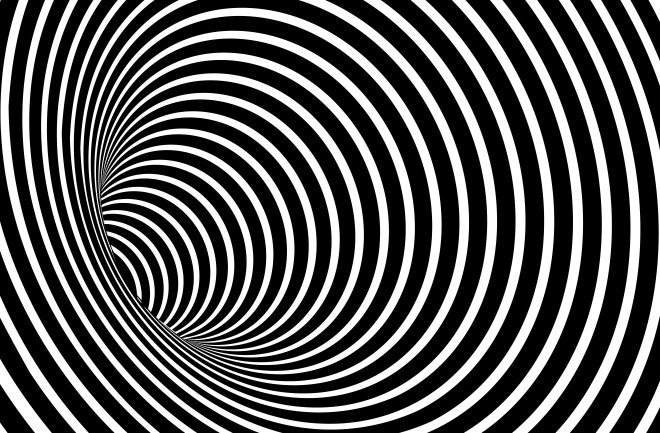In an art class, I learned that black and white aren't colors in the strictest sense: They consist of a complete lack of color on the one hand and an equal combination of all colors on the other. I never found this explanation very satisfying. If black and white aren't colors, I wondered, then what precisely are they?
And what about gray? Can you really get something (gray) by mixing equal amounts of nothing (black) and everything (white)? It turns out the answer is yes, but the something you get needn't be gray. It can be a bona fide color, as you'll discover by doing the following experiments.
Optical Illusion Experiment 1
Hold a page 10 inches from your face. Place a fingertip between the second and third rows on the left edge of the pattern above, and focus on your finger as you slide it quickly to the far right side of the figure and back to the left edge. On the left-to-right scan, the right-facing black "teeth" should take on a brownish tint while the left-facing teeth should appear bluish. When your finger makes a right-to-left traversal, the colors in the rows should reverse.
Hues derived from rapid movement of black-and-white patterns across your retinas are called subjective colors. These baffling tints were first documented by the 19th-century physicist Gustav Theodor Fechner, who formed them by spinning patterned disks like the one shown at right.
Optical Illusion Experiment 2
Re-create Fechner's original study by cutting out the disk, pasting it on cardboard, skewering its center on a toothpick or thumbtack, then giving it a vigorous spin. Bands of different pastels should be readily apparent as the disk moves. Reversing the spin will produce a different set of colors. (If you don't see colors immediately, try spinning the disk at different speeds.)
Some research suggests that subjective colors may be caused by the varying response of different receptors in your eyes. The sensation of color arises from neural excitations in visual photoreceptors called cones, which come in three flavors: those most sensitive to either blue, green, or red wavelengths of light. All visible wavelengths excite all three cone types to one degree or another, but when the amount of stimulation of all three cone systems is equal, we see white. (White dims to gray or black when the relative stimulation of the three cone systems stays equal but the intensity of light decreases.)
When presented with rapid on-off stimuli in black and white, each of the three types of cones turns on and off with a slightly different delay, and this momentary imbalance triggers the perception of color. For instance, a brief black-white-black sequence will take longer to turn on the blue-sensitive cones than the green and red variety, producing an initial sensation of yellow or brown (both are mixtures of red and green light), quickly followed by a transient perception of blue. Reversing the order of stimulation to white-black-white swaps the order in which yellow and blue sensations occur (hence the reversal effects in our two experiments).
These strange effects prove that there's more to color vision than meets the eye!
Check out an animation of the Fechner color illusion: dogfeathers.com/java/fechner.html.

